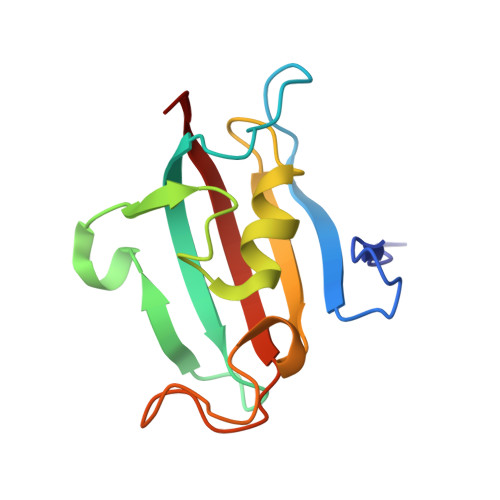Coupling of Conformational Transitions in the N-terminal Domain of the 51-kDa FK506-binding Protein (FKBP51) Near Its Site of Interaction with the Steroid Receptor Proteins.
LeMaster, D.M., Mustafi, S.M., Brecher, M., Zhang, J., Heroux, A., Li, H., Hernandez, G.(2015) J Biological Chem 290: 15746-15757
- PubMed: 25953903
- DOI: https://doi.org/10.1074/jbc.M115.650655
- Primary Citation of Related Structures:
4R0X - PubMed Abstract:
Interchanging Leu-119 for Pro-119 at the tip of the β4-β5 loop in the first FK506 binding domain (FK1) of the FKBP51 and FKBP52 proteins, respectively, has been reported to largely reverse the inhibitory (FKBP51) or stimulatory (FKBP52) effects of these co-chaperones on the transcriptional activity of glucocorticoid and androgen receptor-protein complexes. Previous NMR relaxation studies have identified exchange line broadening, indicative of submillisecond conformational motion, throughout the β4-β5 loop in the FK1 domain of FKBP51, which are suppressed by the FKBP52-like L119P substitution. This substitution also attenuates exchange line broadening in the underlying β2 and β3a strands that is centered near a bifurcated main chain hydrogen bond interaction between these two strands. The present study demonstrates that these exchange line broadening effects arise from two distinct coupled conformational transitions, and the transition within the β2 and β3a strands samples a transient conformation that resembles the crystal structures of the selectively inhibited FK1 domain of FKBP51 recently reported. Although the crystal structures for their series of inhibitors were interpreted as evidence for an induced fit mechanism of association, the presence of a similar conformation being significantly populated in the unliganded FKBP51 domain is more consistent with a conformational selection binding process. The contrastingly reduced conformational plasticity of the corresponding FK1 domain of FKBP52 is consistent with the current model in which FKBP51 binds to both the apo- and hormone-bound forms of the steroid receptor to modulate its affinity for ligand, whereas FKBP52 binds selectively to the latter state.
- Wadsworth Center, New York State Department of Health, Albany, New York 12201; Department of Biomedical Sciences, School of Public Health, University at Albany, SUNY, Albany, New York 12201.
Organizational Affiliation:
















